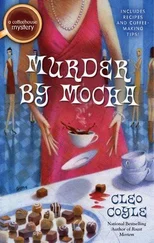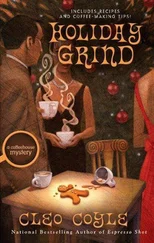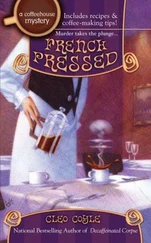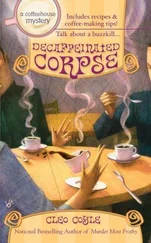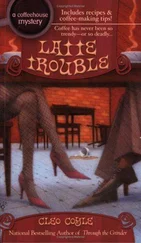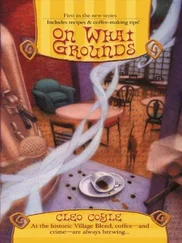Roasting Stages
Given all of the factors that can influence a coffee’s flavor, roasting has the greatest impact. As Clare well knew from her Village Blend roasting room, “The right kiss of heat would bring out the absolute best flavors in these green beans — and the wrong would destroy them forever.”
The roasting itself goes relatively quickly, 11 to 18 minutes. Here is a short list of very basic steps that should give you a general overview of a typical small-batch roasting process.
Stage 1 — Raw Green Coffee:The green, grassy-smelling beans are released from the roaster’s hopper into its large drum. The drum continually turns the beans to keep them from scorching. As the beans dry and cook, they start to turn yellow to yellow-orange in color and give off aromas like toasted bread, popcorn, or buttery vegetables.
Stage 2 — Light, Cinnamon, New England-Style:As they continue to roast, sugars start to caramelize and the beans begin to smell more like roasting coffee. At around 400°F, the small, hard green bean doubles in size, becomes a light brown color, and gives off a popping or cracking sound, which is why this stage is called “the first crack” stage. What the master roaster is seeing now is the change in the chemical composition of the bean. (The process is called pyrolysis and it includes a release of carbon dioxide.) The acidity or “bright” notes in this coffee will be powerful, and its unique characteristics (based on the origin and processing of the beans) will be pronounced, but the body will be pretty thin. The surface of the light brown bean will be dry because the flavor oils are still inside.
Stage 3 — Light-Medium, American Style:The temperature rises to about 415°F and the color of the bean changes from light brown to medium brown. The acidity or “bright” notes are still there but not as strong. The characteristics of the varietals will still be pronounced but the body will be fuller. For residents of the East Coast of America, this is the traditional roasting style.
Stage 4 — Medium, City:The temperature rises from 415° to 435°F and the color of the bean is a slightly darker medium brown. The subtle flavor notes in the varietals are not as strong but still quite clear, the acidity or “brightness” is still present, and the body is even fuller. This is the traditional style for the American West.
Stage 5 — Dark-Medium, Full City, Viennese Style:Now we are moving toward “the second crack” stage (this stage sounds less like corn popping and more like paper crinkling). This second pyrolysis usually happens between 435° and 445° F, the roast color is dark medium brown, and the beans begin to take on a slick sheen as the roasting “sweats out” the oils. The smell in the air is sweeter, the body of this coffee is heavier, the acidity or “brightness” more subdued. Coffees with more pronounced characteristics (such as Kenyan) will retain their strong flavor notes, but those with subtler notes will be lost to the increasing caramelized “dark roast” flavor of the process. Coffee drinkers in the Pacific Northwest, including northern California, traditionally enjoy this style of roast.
Stage 6 — Dark, Darker, Darkest:Continuing to roast from this point will yield increasingly darker styles of roasted coffee. (See the basic styles and temperatures below.) Sugars continue to caramelize and more oils will be forced to the surface. The roasting smells turn from sweeter to more pungent and finally smoky. Pushed to the limit, beans will turn very dark and shiny, taking on intense flavors before they become completely black, charred, and worthless.
* Espresso, European Style:(445° to 455°F) This style of roast displays a moderately dark-roast flavor.
* French, Italian:(455° to 465°F) This style has more of a bittersweet dark-roast taste. While too pungent for some coffee drinkers, these roasts will stand up to mixing with milk and other flavorings to create coffee drinks.
* Dark French, Spanish:(465° to 475°F) The more bitter side of the “bittersweet” flavor is displayed here. A smoky taste may also be present. As the beans continue to roast, charred notes will begin to appear, and regardless of their origin all beans will begin to taste about the same.
Stage 7 — Cooling:The master roaster will monitor this process by temperature gauges but also by sound (crack or pop), smell, and sight (bean color). When the desired roast style is achieved, the process is stopped by the release of the beans from the heated drum. The still-crackling beans fall into a cooling tray where fans and stirring paddles quickly bring down their temperature. When completely cooled, they are ready for grinding, brewing, and (finally!) drinking.
Recipes
With a contented stomach, your heart is forgiving; with an empty stomach, you forgive nothing.
— Italian proverb
Eat with joy!
— Cleo Coyle
Madame’s Osso Buco
See photos of this recipe at www.CoffeehouseMystery.com
Osso Buco (or ossobuco ) is an elegant and beloved Italian dish of veal shank braised in wine and herbs. The shank is cut across the bone to a thickness of roughly 3 inches, browned, and then braised. Braising is a very slow cooking process, but preparing the dish itself is relatively simple, and the results pay off with rich, borderline orgasmic flavor. This is the recipe Madame shared with Diggy-Dog Dare in the Elmhurst ER. It was taught to her by Antonio Allegro, her first husband and Matt’s late father.
Makes 3-4 servings
3-4 veal shank crosscuts, about 3 inches thick (see your butcher)
½ teaspoon sea salt
½ teaspoon freshly ground black pepper
½ cup all-purpose flour
3 tablespoons olive oil
1 large yellow onion, diced
1 large carrot, diced
4 celery stalks (hearts), sliced
4 garlic cloves, minced
1 cup dry white wine (such as Pinot Grigio)
1-2 cups chicken or veal stock (see note)
1 tablespoon minced fresh rosemary
1 teaspoon minced fresh thyme
Gremolata (a simple garnish; recipe follows)
Step 1 — Brown the shanks:Preheat oven to 350° F. Season shanks with salt and pepper, then dredge in flour and set aside. Heat the olive oil in a Dutch oven over medium-high heat until the oil is rippling but not smoking. Place the veal in the hot oil and sear the shanks on both sides, turning once (about 4-5 minutes per side). Remove veal from oil and set aside.
Step 2 — Prepare the aromatics:Drain most of the fat and oil from the Dutch oven, leaving just enough to cover the bottom. Add the onion and cook for 6 minutes, until brown. Add the carrot, stirring occasionally, about 3 minutes. Add the celery and garlic, stirring frequently, until they release their flavor and become aromatic, about 2 minutes. (Do not dump everything in at once, the order is important for the best flavor results.)
Step 3 — Deglaze and prep the broth:Add the wine to the pan, stirring to incorporate all the ingredients. Simmer for 4-5 minutes, until the wine is reduced by half. Return the veal shanks to the pan, along with all the juice it may have released while sitting. Add enough chicken or veal stock (about 1 to 2 cups) to cover the shanks about two thirds of the way.
Step 4 — Simmer and braise the meat:Over a low heat, bring the pot to a gentle simmer, then cover and transfer to hot oven. Braise for 2 hours, turning occasionally. Then add rosemary and thyme, and braise for one more hour, removing the lid during the last 15-20 minutes to cook off excess liquid.
Читать дальше



